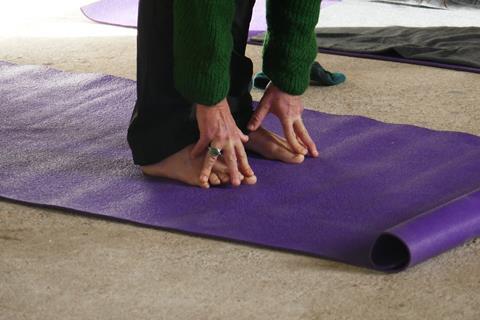Cellist Ruth Phillips looks at the connections between yoga, playing an instrument and making music through the elements of breath, gravity and the wave

This is a preview of a longer article published in the May 2019 issue of The Strad in which Ruth Phillips, in collaboration with her colleague Jane Fenton, have taken the three elements breath, gravity and the wave and chosen three asanas (postures) with which to illustrate them, while revealing how both Pablo Casals and yoga guru Vanda Scaravelli have informed her musical ideas
BREATH
By tuning in to the subtle way in which the breath initiates movement, we tune in to the way the body wants to move, rather than telling it how we want it to move. Allowing the movement of our limbs to flow from that listening, we build trust in the body’s own intelligence, and a sense of peace supports even the fastest, most vigorous gesture.
One of the simplest sequences in which to feel the breath moving the body is in Apanasana. Quietening our minds and allowing the breath to lead the movement, this is a beautiful way to experience freedom in the hips and the lower back. By creating space in the belly on the exhalation, we can fold our legs effortlessly towards the chest, while on the inhalation they are guided gently away. There is no pushing or pulling, just responding to the breath. Having felt this release on the floor, we can then invite a similar response in the arms in standing. The ribcage fills with air and empties, and the arms follow, floating away from and back towards the torso, and the shoulder, wrist and elbow joints become free. This in turn can lead to an experience of bowing which is more like the opening and closing of a bird’s wing than our habitual lifting and pressing.
GRAVITY
From the feeling of our feet on the floor to our fingers on the instrument, we spend a surprising amount of effort opposing gravity. Sometimes the sheer weight of our arm inspires panic. We often compensate for wanting to be taller, shorter, heavier or lighter by overarching the back, hunching over or holding the belly in, while anxiety about being seen or heard can cause us to go into fight–flight–freeze response, creating blockages in the body. Abandoning ourselves to gravity is something that many of us have forgotten how to do, yet, happily, we can practise it.
In the standing ‘mountain pose’ Tadasana, we start by waking up the feet. We remind each part (each toe, the inside, the outside, the ball and the heel) of the importance of its role in receiving and transmitting weight into the ground through the bones. Only then, when each bone in the foot is taking full responsibility for its role in weight-bearing, can the muscles relax. We can translate this exact experience into our fingers, as they receive and transmit weight into the string through the bow.
String players often experience more strain during long quiet passages than during loud ones because holding the full weight of the arm – on average 5.3 per cent of our body weight, about 7 pounds – away from the string with muscle strength is exhausting. If we work with, rather than against, the force of gravity, we need only reorganise the shape of the arm so that the weight falls either through the elbow towards the floor (playing quietly) or directly into the string (playing loudly).
THE WAVE
The word ‘posture’ often implies a relationship, and as a performer in relationship with an audience, one person might adopt a posture in order to hide, while another might do so to show off his skill or ‘interpretation’.
The ‘cat to cow’ sequence in yoga can be a powerful way to explore postures we adopt when we play as it takes us from flexion of the spine (‘cat’ – a closing of the body, often used to protect ourselves) to extension of the spine (‘cow’ – an opening of the body, often used to project ourselves). When the movement of the spine is led by the breath, we experience postures not as fixed affectations but rather as shapes through which we continuously flow. On an emotional and spiritual level, we come to experience that flexion can embody not only closing, protection and fear, but also receiving, inner listening and inspiration, while extension can embody not only opening and projecting, but also giving, releasing and expression.
The next Breathing Bow retreat with Ruth Phillips will take place 8–11 July 2019 in Provence, France. thebreathingbow.com
Jane Fenton will give yoga classes at ESTA (UK) Summer School, Chichester University, 11–16 August 2019
The digital magazine and print edition are on sale now










































No comments yet